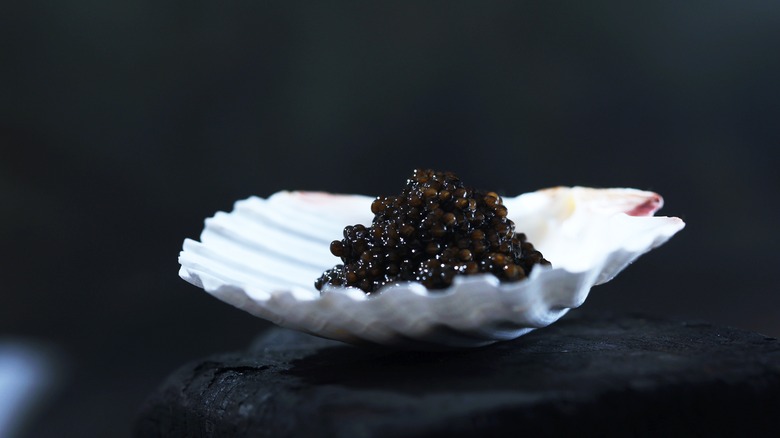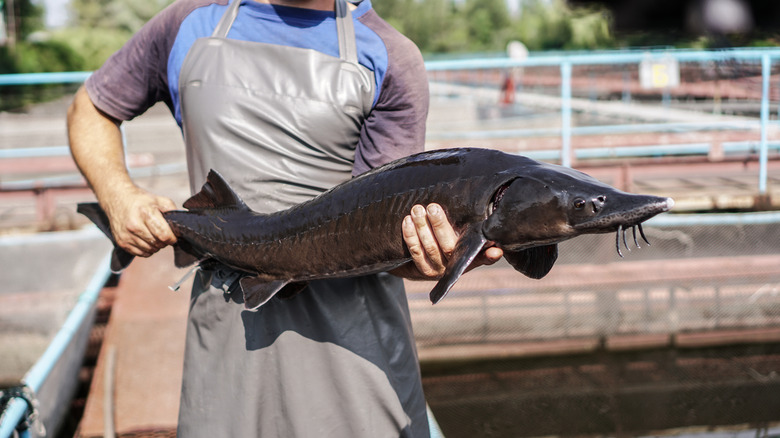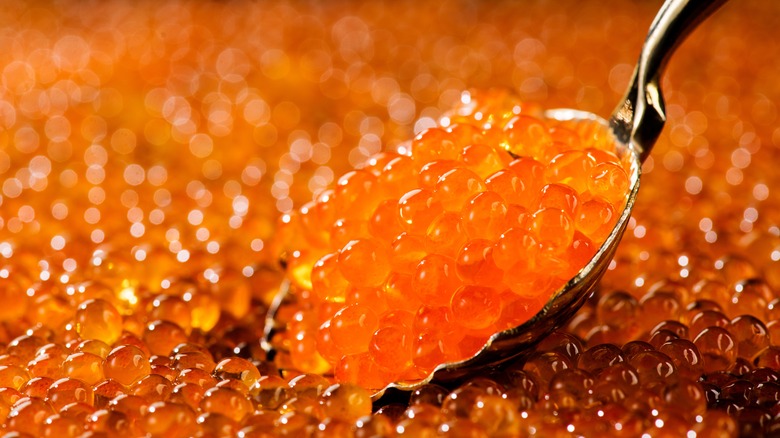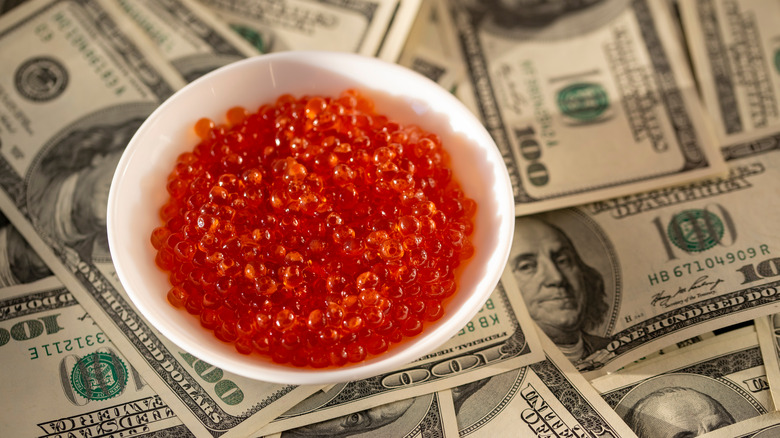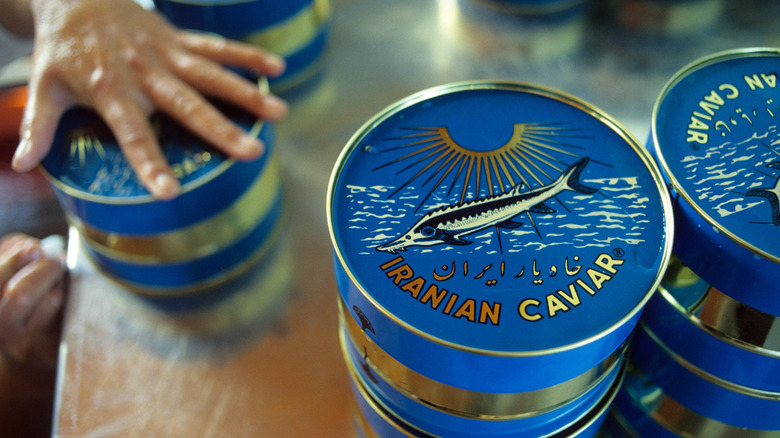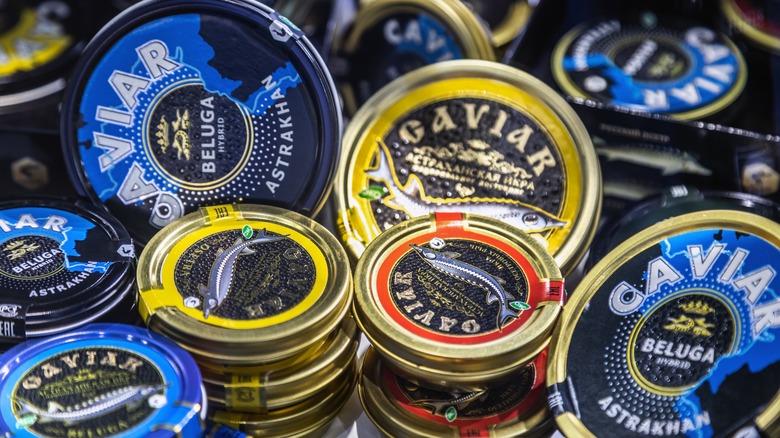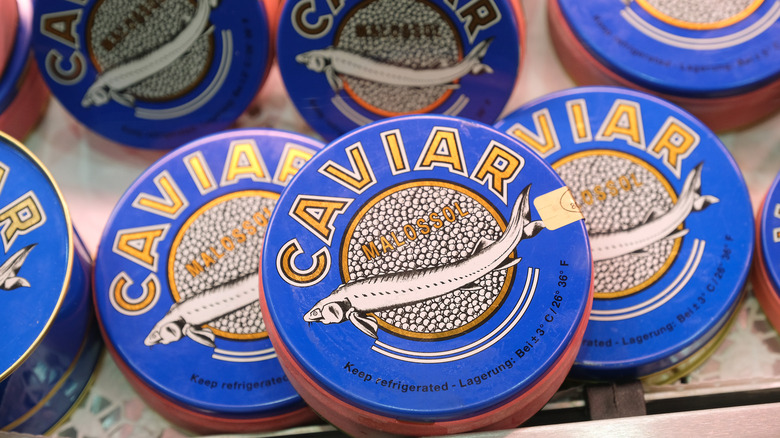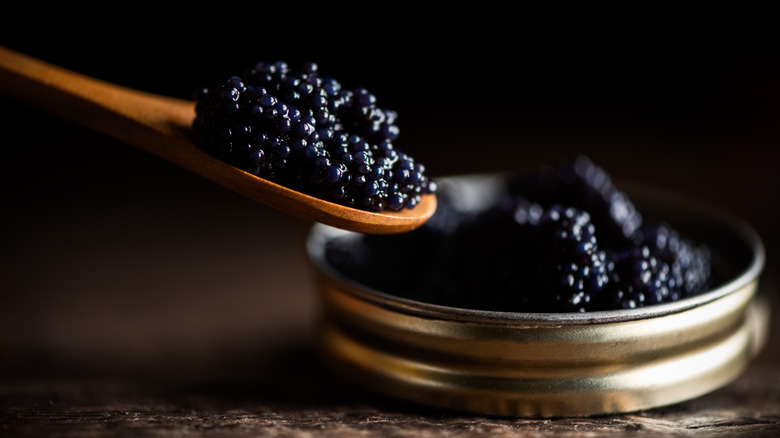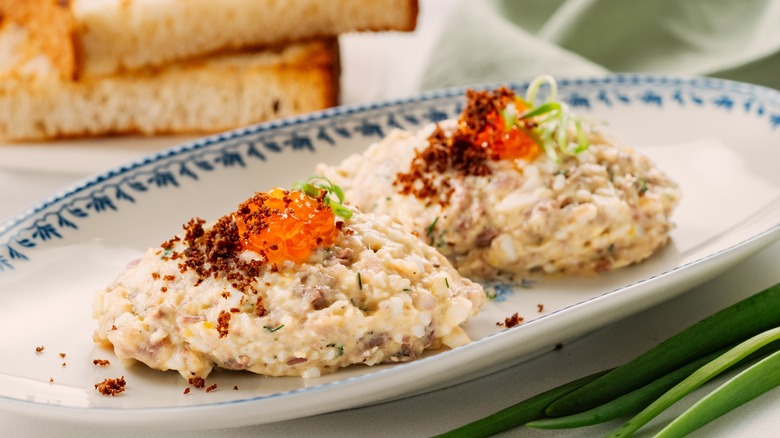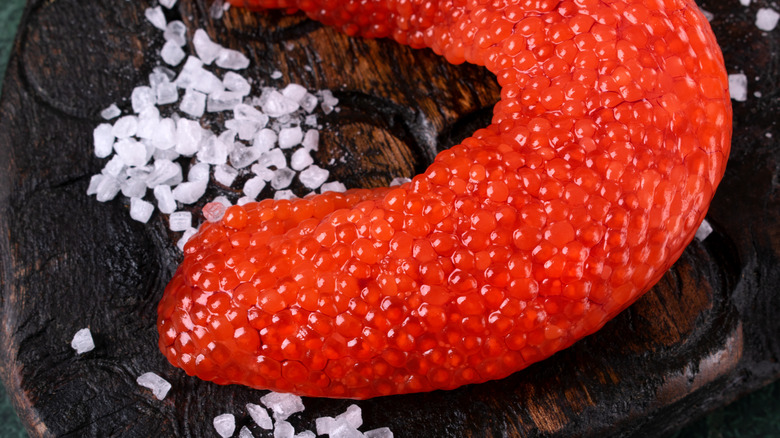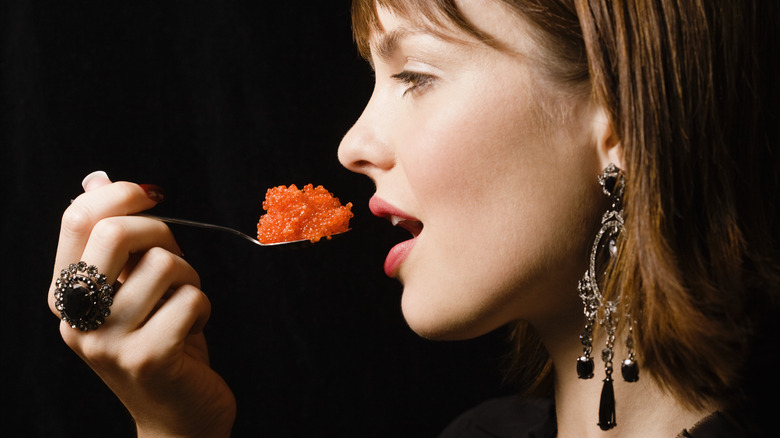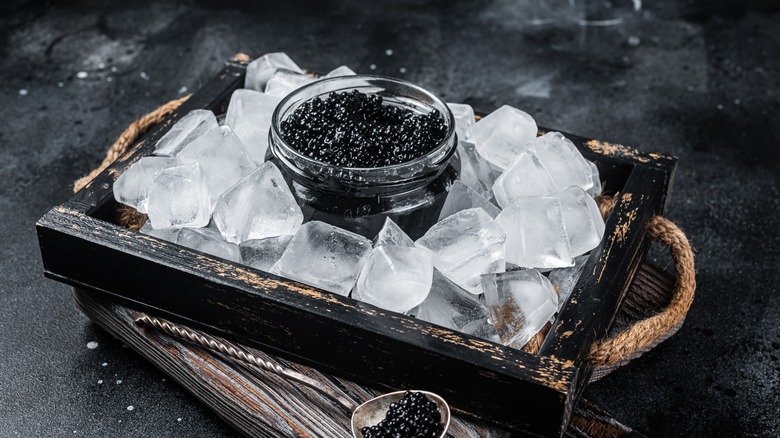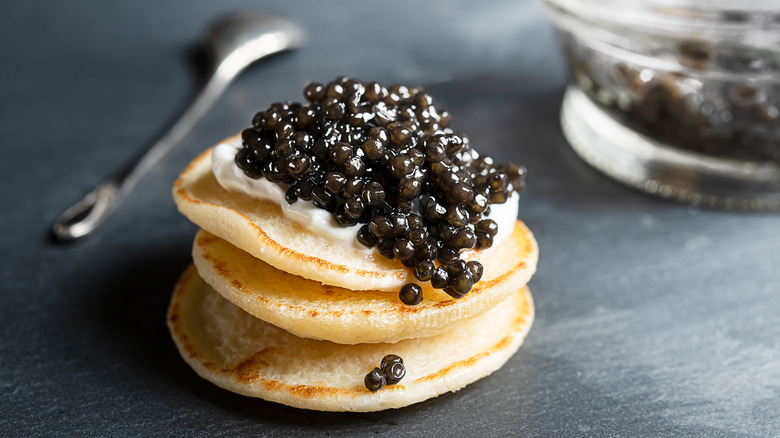14 Longstanding Myths About Caviar, Debunked
Given its exclusive status in the culinary world, cultivated by rarity and often eye-watering prices, caviar is a food that most people have heard about but unlikely tried. As a result, more than a few myths have arisen about the mysterious, luxury dish.
Caviar is almost always portrayed as something reserved solely for the elite, and it's true that it's long been favored by the rich as a status symbol. When people realize that caviar is essentially just fish eggs, they often write it off as meaningless excess, bought and consumed to display opulence rather than savored for its flavor. The reality, however, is a little more complex. Caviar does have a longstanding reputation as a favorite of the wealthy, and the prices it can command are, quite frankly, ridiculous. However, there's more to caviar than meets the eye, and it's more enjoyable, accessible, and versatile than you might think. That said, it's time to unpick some of the long-held misconceptions surrounding caviar.
Caviar can only come from wild sturgeon
Depending on who you ask, you might be told that for caviar to be considered the real deal, it has to come from wild sturgeon. Even still, it might not be considered caviar unless it comes from the Black Sea or Caspian Seas that straddle the border of Europe and Asia.
Now, there are some organizations that consider this true; however, these are primarily wildlife protection organizations, like the WWF. The designation is most likely maintained to preserve the sturgeon's habitats and prevent overfishing due to demand for caviar. According to these bodies, roe that doesn't come from the sturgeon must be called a "substitute of caviar." That said, many use the term caviar to refer to roe from other types of sturgeon and fish such as salmon, paddlefish, trout, or carp. Ultimately, you shouldn't get too caught up in whether a type of roe can be called true caviar or not. Japanese cuisine, for example, commonly features many types of roe, and they have their own names for each kind, and they're all uniquely delicious in their own way. The quality and flavor are far more important, and it's only worth being picky if you're looking to pay a lot of money for a specific kind.
Caviar is always black
When you see caviar depicted on-screen, it's nearly always a rich, inky black color. While this is generally what the roe from wild saltwater sturgeon looks like, it's not always the case.
Firstly, the exact color of the caviar can vary depending on the type of fish, its diet, and its environment. Even "true caviar" can come from different types of sturgeon, with hues that include black, gray, silver, brown, amber, or gold — there's even a type of albino sturgeon that produces pale yellow roe. Then, you've got the non-sturgeon caviar, coming from salmon, trout, whitefish, and carp, for example. These tend to be red, pink, or orange in color, depending on the species, and some caviar, like that from the lumpfish, is even dyed red or black to give it extra visual appeal. Some farm-raised fish will also produce a different colored roe than their wild counterparts due to the type of feed they're raised on. At the end of the day, it doesn't matter if your caviar is black, as long as it's the color you'd expect from the type of roe you're eating.
Caviar is incredibly expensive
Caviar has a reputation for being an extreme luxury, an indulgence only enjoyed by the fabulously wealthy. If you start researching the prices of premium caviar from wild sturgeon, you'd be forgiven for assuming it's a food reserved for those with mountains of cash to burn.
Prices for true caviar start around $100 to $200 per ounce, with a kilogram costing anywhere from thousands to tens of thousands of dollars. When you see a can of fancy fish eggs selling for what would be life-changing money for most people, it's easy to get turned off by the idea of ever trying it. However, as we already mentioned, there are plenty of different types of caviar out there and many, while not necessarily a budget item, are far more affordable. Domestic salmon roe can cost as little as $8 an ounce — not pocket money, but not a price tag reserved for multi-millionaires. You'll also find that caviar from farm-raised fish tends to be cheaper, as it's more widely available and a sustainable source of roe.
Russian caviar is the best caviar
When most of us think of caviar, we usually associate it with Russia, and with good reason. Caviar was originally sourced from the Black and Caspian Seas, both of which have coastlines belonging to Russia, and it's been considered a status symbol within the country's cuisine for centuries.
In time, Russia began exporting the delicacy abroad where its reputation grew, gaining fans among the elite all over the world. However, Russia isn't the only country with coastal fishing access to the Black and Caspian Seas. Iran, in particular, is known for producing some of the best caviar around. The development of modern fish farms and the sourcing of roe from other fish species means other countries have also been able to produce superb caviar, including foodie nations like France and Italy. Perhaps unsurprisingly, China has also made massive waves in the caviar market. Today, China is the largest producer of caviar in the world, offering a combination of budget-friendly roe and caviar of a quality fit for the finest restaurants.
Beluga caviar is illegal in the United States
You may have heard that beluga caviar — one of the most sought-after and expensive types around — is illegal in the United States, taking it off your menu even if your bank balance allows it. Until a few years ago, this was true, and importing it was considered a federal offense.
In 2005, the U.S. recognized the beluga sturgeon as a threatened species under the Endangered Species Act — not a rating as severe as "endangered," but enough to warrant a ban on the importation of beluga caviar. The U.S. once had its own booming caviar market until overfishing killed the industry at the turn of the 19th century, so they were aware of the dangers of unsustainability. For over a decade, those wealthy enough to afford beluga caviar had to travel to the source to enjoy it, as although it wasn't illegal for consumption in the U.S., there was no legal way to get it into the country. However, that changed in 2019 when a single U.S. company — Sturgeon Aquafarms in Florida — was given the legal go-ahead to sell authentic beluga caviar. Because of their state-of-the-art, sustainable farms, caviar has since bounced back domestically and is now trending on fine-dining menus across the United States.
Caviar must be fresh
It's no secret that fresher is better when it comes to the majority of foodstuffs, and if you're paying out for caviar, you're going to want to make sure it isn't past its best. However, fresh caviar is highly perishable and can spoil in as little as 24 hours.
Unless they expect to rely on a clientele so abundantly wealthy that they're able to fly in fresh caviar on a private jet — which has almost certainly happened at some point — it's reasonable for caviar producers to find ways to preserve their product for transportation. Fortunately, there are plenty of tried and tested food preservation techniques that can help caviar stay fresh until it's ready to be eaten. For starters, almost all caviar is sealed in a jar or can that prevents it from spoiling immediately. It's often cured with salt, too, to help it last longer, although the amount of salt varies, with higher grades of caviar using as little as possible to retain as much of the delicate flavor as possible. Even sealed caviar should be kept refrigerated. The exception is if it's been pasteurized, and while this can extend its unopened shelf life to over a year, there's a noticeable drop in quality.
Caviar has to be eaten with fancy tableware
While there's some truth to the idea that caviar should only be handled with a special type of tableware, it's an idea that's often misconstrued. You'll often hear people mention how fine silver is the material of choice, but the reality is that almost any metal utensil is a bad idea.
The issue is oxidation. Most non-alloyed metals oxidize over time, eventually tarnishing or rusting, but the chemical processes involved start occurring before they're visible to the naked eye. When these metals come into contact with delicate foods like caviar, they impart an unpleasant, metallic flavor. Caviar connoisseurs often use spoons made with non-reactive, non-metallic materials such as mother-of-pearl or animal horn. Gold is also an option, as it doesn't oxidize in its pure form. However, there are plenty of cheap and accessible alternatives that are just as suitable, if not as luxurious. A wooden spoon is a fine option, although it may start to absorb oils and off-smells with prolonged use. Plastic utensils, while generally seen as particularly un-fancy, will also do the trick and are far better suited than anything made of metal.
Caviar is bad for you
We commonly associate fine foods with the idea of excess, perceiving them as gluttonous, or assuming anything eaten in tiny portions must be bad for us in larger quantities. With caviar, this isn't necessarily the case.
For starters, it's high in protein and packed with vitamins and minerals, including iron and selenium. It's also chock full of vitamin B12, containing more than twice the daily recommendation of the crucial nutrient. It's got a relatively high calorie count and can be high in sodium, although the latter amount varies depending on how much salt is added during the curing process. However, arguably the best feature of caviar is that it's an excellent source of omega-3 fatty acids. These have been linked to a wide range of health benefits, including better cardiovascular health, immune system support, skin vitality, improved fertility, and physical and mental brain health. It also helps that caviar is often enjoyed in small quantities alongside relatively nutritional foods, like fish or sushi, eggs, or potatoes, and its expense makes it a tricky food to overindulge in.
Caviar tastes extremely fishy
One could assume, given that it comes from a fish, that caviar has an overtly fishy flavor but this doesn't tend to be the case. The specific tasting notes of caviar differ from style to style; however, "fishy" isn't an adjective that comes up as often as you might think.
Caviar has a notable briny quality that most of us associate with fish and seafood, but that's not the same as something tasting fishy, and the salinity should feel light and clean on your palate. If you're a fan of sushi, you'll also appreciate that fresh fish doesn't really taste fishy in the pejorative sense of the word, rather it has a uniquely savory, umami profile. This is what you can expect from good roe, with premium caviar boasting more delicate and nuanced flavors that can be sweet, nutty, buttery, creamy, or earthy instead. If your caviar does taste too fishy, it's likely a sign that it's past its best or of a lower quality.
Caviar is very salty
Given that caviar is a cured product, it's not unreasonable to think that it may be overwhelmingly salty — a feature that some find desirable but can put others off. It's true that caviar has a natural salinity, but the good stuff tends to be pleasantly balanced.
Although the type of caviar can influence its overall saltiness, the main factor is how much salt is used in the curing process. The highest grade of caviar is preserved using what's known as the malossal process, a word that translates to "little salt" in Russian. This method keeps the salt content below 5% and strikes a delicate balance by preserving the caviar while gently enhancing its natural flavors. As the quality of the caviar drops, more salt is usually added, prioritizing shelf stability over flavor. The level down from malossal caviar is what's known as pressed caviar, as it's compressed into a type of jam after more salt is added, and the step below that is referred to as semi-preserved, containing around 8% salt — enough that it can remain stable without refrigeration.
Caviar needs to be chewed
One of the more common myths surrounding roe is that it should be chewed, but chewing caviar isn't the way to go if you're hoping to benefit from the full tasting experience. At least, not unless you've miraculously developed taste buds in your back teeth.
Caviar is a delicate luxury and should be savored as such, spending as much time in contact with your taste-sensitive tongue as possible. Start by taking a moment to appreciate the aroma of your caviar, then, as you bring the spoon to your mouth, invert it to deposit the roe directly onto your tongue. Spend a little time rolling the eggs around your tongue and they'll gradually melt in your mouth, revealing layer upon layer of flavor, giving you time to appreciate each aspect of the caviar. Some types of caviar are more robust than others and won't melt quite as easily, and you can gently pop these by using your tongue to press them against the roof of your mouth to release the juice inside.
Caviar should be served ice cold
The storage and serving temperatures of caviar are often misunderstood. In part, this is due to how high-quality caviar is kept stable.
As we mentioned earlier, high-grade caviar that keeps salt levels to a minimum needs to be kept refrigerated in order to remain stable. This in itself can be a little tricky, as the recommended storage temperature for caviar — between 28 and 32 degrees Fahrenheit — falls slightly below what most fridges provide but is higher than you'll get from your freezer. If you store caviar at the perfect temperature and serve it immediately, it's likely going to be too cold for you to appreciate all of the delicate flavors. The trick is to take the caviar out in a room-temperature environment and let it warm up slightly for about 10 minutes before opening. Then, place the container or serving dish on a bed of ice. This is the best way to avoid masking the caviar's flavors while preventing it from getting too warm and spoiling in the open air.
Caviar must be enjoyed on its own
There are many luxuries that are best savored on their own — you wouldn't mix a fine scotch with Coke or slather Kobe steak in barbeque sauce, for example. Caviar, however, is versatile enough that it benefits from being paired with other ingredients.
One of the most common ways to enjoy caviar is atop blinis, a bite-sized Russian pancake that's simple enough to make at home. Often, these are served with sides such as crème fraîche, eggs, baked potato, or wedges of tart citrus fruit. Less premium roe is a common sushi garnish, but it can work just as effectively with other fresh fish dishes like ceviche or smoked salmon tacos. With caviar making its comeback in the U.S., there are also a number of unconventional pairings making the rounds, including the odd-sounding yet delicious combination of caviar on potato chips that offers a nearly limitless number of flavor possibilities. When caviar was solely a treat for the elite, creativity was rarely a financially sound venture, but the availability or cheaper options make it an ingredient well worth experimenting with.
Caviar should only be paired with Champagne
When it comes to picking a drink to accompany caviar, many of us envisage quaffing a glass of good Champagne between bites, likely due to the luxury status of the two items. While nobody would fault you for this combo, there are better choices for truly appreciating caviar.
The traditional pick is a reliable Russian vodka, long favored by those who popularized caviar. A quality vodka will taste clean enough that it won't interfere with the delicate profile of caviar, while the strength of the spirit will cut through the fat and the salinity. If you're after something that has its own flavor that will effectively complement or contrast with the caviar, well, there's not really a catch-all answer. Wine can be an excellent choice, but styles of caviar vary enough that you'll want to pick a bottle that matches the specific flavor profile of the roe. An uncommon yet increasingly popular choice, however, is beer. Although you won't want to reach for a weighty IPA, lighter styles like hefeweizens can make for a uniquely delicious pairing.

